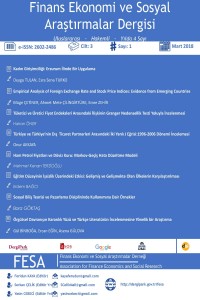TÜRKİYE VE TÜRKİYE’NİN DIŞ TİCARET PARTNERLERİ ARASINDAKİ İKİ YANLI J EĞRİSİ: 1996–2006 DÖNEMİ İNCELEMESİ
Öz
Çalışmada, 1996Q1 ile 2006Q4 dönemi
içinde çeyrekli veriler kullanılarak, Türkiye ve Türkiye’nin dış ticaretinde
önemli paya sahip olan ülkeler (Almanya, Fransa, Amerika Birleşik Devletleri,
İngiltere, İtalya, vb.) arasındaki J eğrisinin kısa ve uzun dönemde ölçülmesi
amaçlanmaktadır. Yapılan analizlerde ele alınan ülke verileri için gerekli
birim kök testleri kullanılacaktır. Ayrıca değişkenler arasındaki kısa ve uzun
dönemli ilişkinin belirlenmesi için Bounds Sınır testi kullanılacaktır.
Anahtar Kelimeler
Dış Ticaret J Eğrisi Bound Testi Birim Kök Testi Eşbütünleşme
Kaynakça
- Bahmani-Oskooee, M. (1985) Devaluation and the J-curve: some evidence from LDC’s, The Review of Economics and Statistics, 67, 500–504. Bahmani-Oskooee, M. (1989a) Devaluation and the J-curve: some evidence from LDC’s: errata, The Review of Economics and Statistics, 71, 553–4. Bahmani-Oskooee, M. ve Alse, J. (1994) Short-run versus long-run effects of devaluation: error correction modeling and cointegration, Eastern Economic Journal, 20(4), 453–64 Bahmani-Oskooee, M. ve Brooks, T. J. (1999) bileteral J-curve between US and her tranding partners, Weltwirtschaftliches Archiv, 135, 156–65 Bahmani-Oskooee, M. ve Goswani, G. G. (2003) A disaggregated approach to test the J-curve phenomenon: Japan vs. her major trading partners, Journal of Economics and Finance, 27, 102–13. Bahmani-Oskooee, M. ve Pourheydarian, M. (1991) The Australian J-curve: a reexamination, International Economic Journal, 5, 49–58. Bahmani-Oskooee, M. ve Ratha, A. (2004) The J-curve: a literature review, Applied Economics, 36, 1377–1398. Bahmani-Oskooee, M. ve Swarnjıt, A.(2003) Bilateral J-Curve between India and her trading partners, Applied Economics, 35, 1037–1041. Bahmani-Oskooee, M. ve Tatchawan, K. (2001) Bilateral J-curve between Thailand and her trading partners, Journal of Economic Development, 26, 107–17. Brissimis, S. N. ve Leventakis, J. A. (1989) The effectiveness of devaluation: a general equilibrium assesment with reference to Greece, Journal of Policy Modeling, 11(2), 247–71. Gupta-Kapoor, A. ve Ramakrishnan, U. (1999) Is There a J-curve? A new e stimation for Japan, Internetional Economic Journal, 13, 71–9. Magee, S. P. (1973) Currency contracts, pass through and devaluation, Brooking Papers on economic Activitiy, 1, 303–25.Mahdavi, S. ve Sohrabian, A. (1993) The Exchange value of the dolar and the US trade balanace: an empirical investigation based on cointegration and Granger causality tests, Quarterly Review of Economics and Finance, 33(4), 343–58. Noland, M. (1989) Japanese trade elasticities and J-curve, Review of Economics and Statistics, 71, 175–9. Peseran, M. H. ve Shin, Y. (1995) An autoregressive distributed lag modeling approach to cointegration analysis, in Centennial Volume of Rangar Frisch (Eds) S. Storm, A. Holly, and P. Diamond , Cambridge University Pres, Cambridge. Peseran, M. H. ve Shin, Y. And Smith, R. J. (2001) Bounds testing approaches to analysis of level relationships, Journal ofApplied Econometrics, 16, 289–326. Rosensweig, J. A. ve Koch, P. D. (1988) The US dolar and the ‘Delayed J-curve’ Economic Review, 7/8, Federal Reserve of Atlanta. Shirvani, H. ve Wilbratte, B. (1997) The relation between the real Exchange rate and the trade balance; an empirical reassessment, Internatıonal Economics Journal, 11(1), 39–49. Zhang, Z. (1996) The Exchange value of the rRenminbi and China’s balance of trade: an empirical study, NBER Working papers Series, Working Paper, 5771.
Ayrıntılar
| Birincil Dil | Türkçe |
|---|---|
| Konular | İşletme |
| Bölüm | Araştırma Makaleleri |
| Yazarlar | |
| Yayımlanma Tarihi | 31 Mart 2018 |
| Gönderilme Tarihi | 6 Şubat 2018 |
| Kabul Tarihi | 16 Mart 2018 |
| Yayımlandığı Sayı | Yıl 2018 Cilt: 3 Sayı: 1 |


